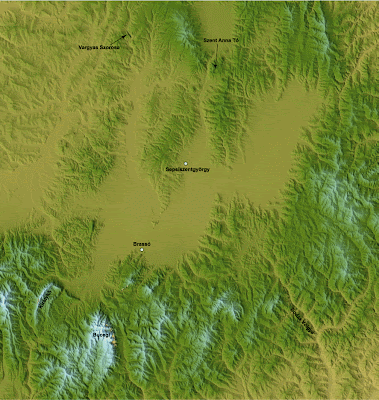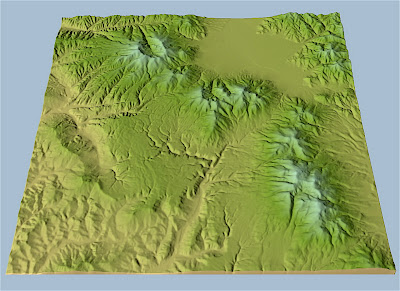Wednesday, March 21, 2007
Sunday, March 18, 2007
A Barcaság és Háromszék morfológiája

Ez a digitális domborzati modell (digital elevation model) az ingyenes 3DEM programmal készült. Az adatokat a USGS honlapjáról lehet letölteni. Néhány számomra fontos helyet bejelöltem a képen. A 3DEM-mel három dimenziós diagramokat is könnyü produkálni. Így néznek ki például a Hargita vulkáni kúpjai:

(Nagyobb felbontásért kattints a képekre.)
Labels:
computers,
geology,
in-Hungarian,
kelet-európa
Kovászna és Komandó nagy felbontásban a Google Earth-en
Kovászna, Gelence és Komandó környéke újabban magas felbontásban látható a Google Earth-en. Így néz ki Kovászna, a háttérben a Siklóval (egy egyenes vonal a bal felső sarokban látható hegyen):

A képre kattintva a nagy felbontású fotó is értékelhető. Persze a legjobb ha az ember ezeket a Google Earth-ben nézi.

A képre kattintva a nagy felbontású fotó is értékelhető. Persze a legjobb ha az ember ezeket a Google Earth-ben nézi.
Labels:
geology,
Google Earth,
in-Hungarian,
kelet-európa
A mások élete (Das Leben der Anderen)

Német Oscar-díjas film a Stasiról, lehallgatásokról, írókról és színészekről, Trabantokkal és Piros Arannyal. Az egyik legjobb film, amit az utóbbi években láttam.
Meg kell nézni.
Labels:
in-Hungarian,
kelet-európa
Saturday, March 17, 2007
No vestige of a beginning, no prospect of an end
When James Hutton saw the unconformity at Siccar Point, where only slightly tilted 345 million years old Old Red Sandstone layers are sitting on top of near-vertical beds of ~425 million years old Silurian greywackes, he realized that such structures could not have formed in only a few thousand years. First, the sediment in the older formation was deposited in horizontal layers; it got buried, compacted and became hard rock; it was tilted to an almost vertical position and lifted above sea level; was eroded by subaerial erosion; and was buried again by much younger sediment that was itself later cemented and tilted by tectonic forces. Most of these processes can be relatively well observed and tracked, especially today, and they are extremely slow compared to most of the things we are dealing with in a human lifetime: both erosion and sedimentation happens at the rate of a few millimeters to centimeters a year, that is, slower than the nail grows. Tectonic movements are not much faster either. Hutton of course had no idea of the absolute age of the rocks, and had no precise measurements of erosion, sedimentation and uplift rates available, but he clearly came to the realization that geology is happening on a timescale a few orders of magnitude larger than that of the Bible and of known human history:
"Here are three distinct successive periods of existence, and each of these is, in our measurement of time, a thing of infinite duration. ...The result, therefore, of this physical inquiry is, that we find no vestige of a beginning, no prospect of an end."Siccar Point is impressive and one of the most important sites in the history of geology, but the unconformity of all unconformities must be the one in Grand Canyon, appropriately called the Great Unconformity. This is how it looks like from Lipan Point, on the southern rim of the canyon:
And here is another shot with a broader perspective:
The tilted reddish strata in the lower part of the first photo are the Dox Formation; the darker rocks above this belong to the Cardenas Basalt. Both of these formations are of Mesoproterozoic age; the overlying horizontal ledge of rock is the Cambrian Tapeats Sandstone. The time gap between the Cambrian and the Proterozoic is 200 million years, about three times longer than the missing time at Siccar Point. Although the unconformity lower in the stratigraphy exposed at Grand Canyon, between the crystalline basement rocks and Mesoproterozoic sediments represents an even larger gap of 475 million years, the 'great unconformity' is visually much more impressive.
It is ridiculous that more than two hundred years after Hutton saw no 'vestige of a beginning', and initiated modern geology, there are people who seriously think that the Grand Canyon was carved by the biblical flood, or that sedimentation and erosion can take place at extremely high rates so that all geologic history would fit into six thousand years.
Such idiocies keep showing up over and over again, and I start to think with Hutton one more time that, unfortunately, there is no prospect of an end.
ps. Suggested readings:
Annals of the Former World by John McPhee; there is a highly readable account of Hutton's discovery of unconformities in the first part of the book, "Basin and Range".
Vestiges of James Hutton - a nice article about Hutton in American Scientist.
Labels:
geology,
in-English,
olvasnivaló,
science,
sedimentology,
skeptical,
travel
Saturday, March 10, 2007
Brazos Bend photos
Updated the 'Brazos Bend State Park' gallery on Smugmug with some new photos that I took a couple of weeks ago.
Néhány új fotó a Brazos Bend Parkból, ahol ezelőtt két héttel csavarogtunk.
Labels:
in-English,
photography,
travel
Thursday, March 08, 2007
Windows on a Mac - with Parallels Desktop
I have been successfully using Windows XP with Boot Camp on the iMac for a while now. However, it is a pain when you have to reboot every time you want to use a Windows application. So I tried the obvious solution: Parallels Desktop for Mac.
And it works like a charm! Initially I could not figure out how to use the Boot Camp installation of Windows, so I actually installed Windows XP as a separate virtual machine, before I realized that it is quite simple to set up Boot Camp (and then deleted the other virtual machine). You have to use "Custom" installation and choose "Boot Camp" as the "virtual hard disk option". The rest is easy (although I did have to kill and restart Parallels once during the first run). Windows asked for reactivation, and I said I wanted to reactivate it, and it worked fine. After all, I still have only one Windows installation on the computer.
So now I can run any Windows application on the Mac, right from the dock, using Parallels "coherence" mode, without even having to see the not-too-attractive Windows XP interface! It is a pretty amazing piece of software (I mean Parallels, not Windows XP). The end result of this setup is that I can run three different operating systems at the same time: Mac OS X, Windows XP, and Unix. And I could install Linux as well, if I wanted to. But I don't need that one right now.
And it works like a charm! Initially I could not figure out how to use the Boot Camp installation of Windows, so I actually installed Windows XP as a separate virtual machine, before I realized that it is quite simple to set up Boot Camp (and then deleted the other virtual machine). You have to use "Custom" installation and choose "Boot Camp" as the "virtual hard disk option". The rest is easy (although I did have to kill and restart Parallels once during the first run). Windows asked for reactivation, and I said I wanted to reactivate it, and it worked fine. After all, I still have only one Windows installation on the computer.
So now I can run any Windows application on the Mac, right from the dock, using Parallels "coherence" mode, without even having to see the not-too-attractive Windows XP interface! It is a pretty amazing piece of software (I mean Parallels, not Windows XP). The end result of this setup is that I can run three different operating systems at the same time: Mac OS X, Windows XP, and Unix. And I could install Linux as well, if I wanted to. But I don't need that one right now.
Labels:
computers,
in-English





